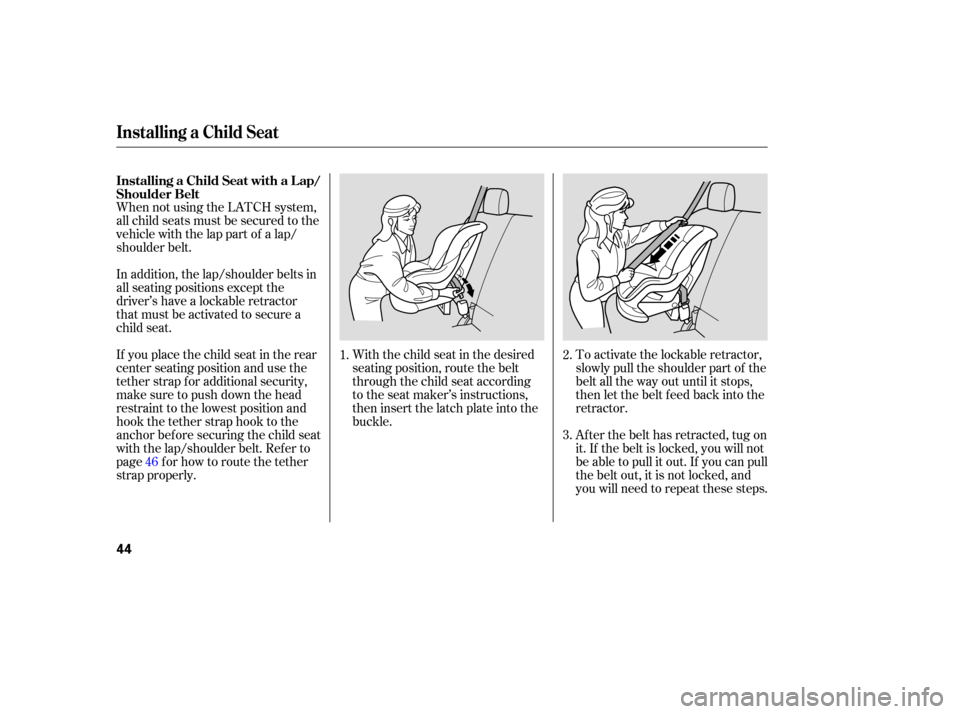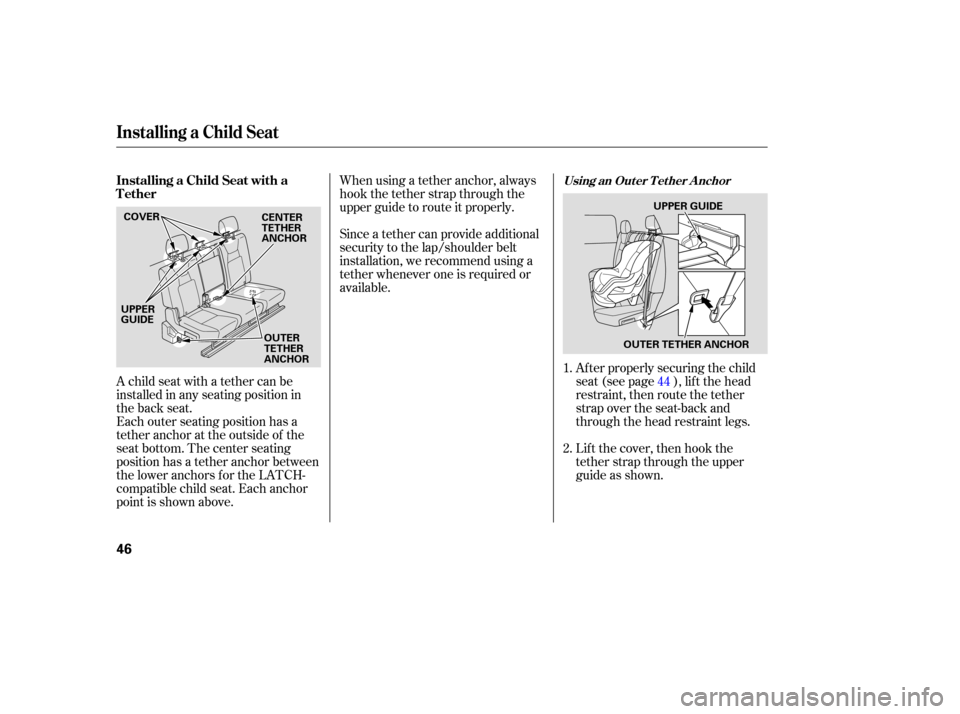Page 47 of 331
Lift the head restraint (see page
), then route the tether strap
over the seat-back and through
the head restraint legs.
Lift the cover, then route the
tether strap around the upper
guide. Route the tether strap
downward properly, making sure
the strap is not twisted, then
attach the strap hook to the tether
an chor on the outside of the seat
bottom (see page ). Push and pull the child seat
f orward and f rom side-to-side to
verify that it is secure. Tighten the strap according to the
seat maker’s instructions.
6.
7.
8.
102
46
On the outer seating position
Installing a Child Seat
Driver and Passenger Saf ety
43
UPPERGUIDE
Outer Position UPPER
GUIDE
Center Position TETHER ANCHOR
TETHER ANCHOR
Page 48 of 331

When not using the LATCH system,
all child seats must be secured to the
vehicle with the lap part of a lap/
shoulder belt.
With the child seat in the desired
seating position, route the belt
th rough the child seat according
to the seat maker’s instructions,
then insert the latch plate into the
buckl e. To
activate the lockable retractor,
slowly pull the shoulder part of the
belt all the way out until it stops,
th en let the belt feed back into the
retractor.
After the belt has retracted, tug on
it. If the belt is locked, you will not
be able to pull it out. If you can pull
thebeltout,itisnotlocked,and
you will need to repeat these steps.
In
addition, the lap/shoulder belts in
all seating positions except the
driver’s have a lockable retractor
that must be activated to secure a
child seat.
If you place the child seat in the rear
center seating position and use the
tether strap for additional security,
make sure to push down the head
restraint to the lowest position and
hook the tether strap hook to the
anchor bef ore securing the child seat
with the lap/shoulder belt. Refer to
page for how to route the tether
strap properly. 1.
2.
3.
46
Installing a Child Seat with a L ap/
Shoulder Belt
Installing a Child Seat
44
Page 49 of 331
Af ter conf irming that the belt is
locked, grab the shoulder part of
the belt near the buckle, and pull
up to remove any slack from the
lap part of the belt. Remember, if
the lap part of the belt is not tight,
the child seat will not be secure.Push and pull the child seat
f orward and f rom side-to-side to
verify that it is secure enough to
stay upright during normal driving
maneuvers. If the child seat is not
secure, unlatch the belt, allow it to
retract f ully, then repeat these
steps.
To remove slack, it may help to
putweightonthechildseat,or
push on the back of the seat while
pulling up on the belt. To deactivate the lockable retractor
and remove a child seat, unlatch the
buckle, unroute the seat belt, and let
the belt fully retract.
4. 5.
Installing a Child Seat
Driver and Passenger Saf ety
45
Page 50 of 331

When using a tether anchor, always
hook the tether strap through the
upper guide to route it properly.
Since a teth er can pro vide additional
security to the lap/shoulder belt
installation, we recommend using a
te ther whenever one is required or
available.
Each outer seating position has a
tether anchor at the outside of the
seat bottom. The center seating
position has a tether anchor between
the lower anchors for the LATCH-
compatible child seat. Each anchor
point is shown above. Lift
the cover, then hook the
tether strap through the upper
guide as shown. Af ter properly securing the child
seat (see page ), lif t the head
restraint, then route the tether
strap over the seat-back and
through the head restraint legs.
A child seat with a tether can be
installed in any seating position in
the back seat. 1.
2.44
Installing a Child Seat
Installing a Child Seat with a
TetherUsing an Out er T et her A nchor
46
COVER
UPPER
GUIDE UPPER
GUIDE
CENTER
TETHER
ANCHOR
OUTER
TETHER
ANCHOR OUTER TETHER ANCHOR
Page 52 of 331
Attach the tether strap hook to the
center tether anchor between the
loweranchorsfortheLATCH-
compatible child seat. Properlysecurethechildseat(see
page ), then tighten the tether
strap according to the seat maker’s
instructions.
Whenever using the tether strap,
make sure to route the strap through
the upper guide bef ore attaching the
tether strap hook to the tether
anchor. If the tether strap is not
routed properly and secured, the
child seat may not be secured. This
could lead to serious injury or death.
5. 6.
44
Installing a Child Seat
48
UPPER GUIDE
CENTER TETHER ANCHOR
Page 55 of 331

If you decide that a child can safely
ride up front, be sure to:
Carefully read the owner’s manual,
and make sure you understand all
seat belt instru ctions and all safety
info rmation.
Move the vehicle seat to the rear-
most position.
Have the child sit up straight, back
against the seat, and feet on or
near the floor.
Ch eck that the child’s seat belt is
properly and secu rely positioned.
Physically,
a child must be large
enough f or the lap/shoulder belt to
properly f it (see pages and ). If
the seat belt does not f it properly,
with or without the child sitting on a
booster seat, the child should not sit
in f ront.
To saf ely ride in f ront, a child must
be able to f ollow the rules, including
sitting properly, and wearing the seat
belt properly throughout a ride.
A side airbag also poses risks. If any
part of a larger child’s body is in the
path of a deploying side airbag, the
child could receive possibly serious
injuries. If the passenger’s front airbag
inf lates in a moderate to severe
f rontal collision, the airbag can cause
serious injuries to a child who is
unrestrained, improperly restrained,
sitting too close to the airbag, or out
of position. The National Highway Traffic Safety
Administration and Transport
Canada recommend that all children
age 12 and under be properly
restrained in the back seat. Of course, children vary widely. And
while age may be one indicator of
when a child can saf ely ride in f ront,
there are other important f actors you
should consider.
Supervise the child. Even a mature
child sometimes needs to be
reminded to f asten the seat belt or
sit properly.
14 49
Physical Size
Maturity
When Can a L arger Child Sit in
Front
Protecting L arger Children
Driver and Passenger Saf ety
51
Page 66 of 331

a problem. For more information, seepage 289.
Theenginecanbeseverelydamaged
ifthisindicatorflashesorstayson
whenth eengineisrunning.For
moreinformation,seepage.
Ifthisindicatorcomesonwhenthe
engineisrunning,thebatteryisnot
beingcharged.Formoreinformation,
seepage. T
hi
si ndica t
orcomesonwhenyou
turntheignitionswitchtotheON
(II)position.Ifitcomeso natany
othertime,itindicatesthatthe
passenger’ ssideairbaghas
automaticallyshutoff.Formore
info rmation,seep age.
Thisindicatorcomesonforseveral
secondswh
enyouturntheignition
switchtoth eON(II)position.Ifit
comeso natanyothertime,it
indicatesapoten tialproblemwith
yourfrontairbags.Thisindicato rwill
alsoalertyoutoapoten tialproblem
withyoursideairbags,passenger’ s
sideairbagautoma ticcutoffsystem,
sidecu rtainairbags,automaticseat
belttensioners,driver’ sseatposition
sensor,andthefrontpassenger’ s
weightsensors.Formore
info rmation,seep age. 29
28
288
288 Malfunction Indicator
Lamp
L ow Oil Pressure
Indicator
Charging System
Indicator Supplemental Restraint
System Indicator
Side A irbag Of f
Indicator
Instrument Panel Indicators
62
U.S. Canada
If this indicator comes on while
driving, it means one of the engine’s
emissions control systems may have
Page 83 of 331

Push the lever up to lock the
steering wheel in position.
Make sure you have securely
locked the steering wheel in place
by trying to move it up and down.
Make any steering wheel adjustment
bef ore you start driving.
Move the steering wheel so it
points toward your chest, not
toward your f ace. Make sure you
can see the instrument panel
gauges and indicators. Push the lever on the lef t side of
the steering column all the way
down.
Pushthebuttontoturnonthe
hazard warning lights (f our-way
flashers). This causes all four
outside turn signals and both turn
indicators in the instrument panel to
f lash. Use the hazard warning lights
if you need to park in a dangerous
area near heavy traffic, or if your
vehicle is disabled. 3.
4.
1.
2. Steering Wheel A djustment
Hazard Warning Button
Hazard Warning Button, Steering Wheel A djustment
Inst rument s and Cont rols
79
Adjusting the steering wheel
position while driving may
cause you to lose control of the
vehicle and be seriously injured
inacrash.
Adjust the steering wheel only
when the vehicle is stopped.